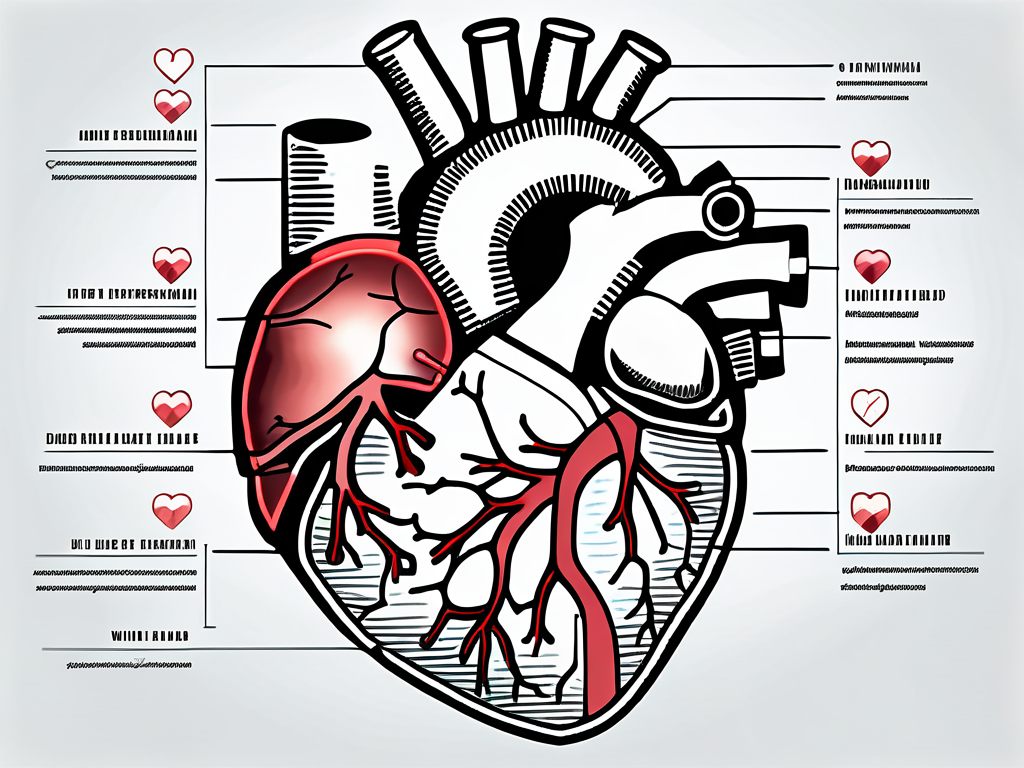A hole in the heart, also known as a congenital heart defect, is a condition that affects the structure of the heart. It occurs when there is an abnormal opening or communication between the chambers or blood vessels of the heart. This article aims to provide an in-depth understanding of heart defects, the symptoms associated with a hole in the heart, the potential complications that may arise, the diagnostic procedures used to detect the condition, and the available treatment options.
Understanding Heart Defects
A heart defect refers to any abnormality in the structure of the heart, which can affect its function. These defects are usually present at birth and are classified as congenital heart defects. They can range from mild to severe and can occur in different parts of the heart.

These congenital heart defects can have a significant impact on an individual’s health and quality of life. While some defects may be minor and require little to no intervention, others can be life-threatening and necessitate immediate medical attention. It is crucial for individuals with heart defects to receive proper diagnosis, treatment, and ongoing care to manage their condition effectively.
What is a Hole in the Heart?
A hole in the heart, also known as an atrial septal defect (ASD) or a ventricular septal defect (VSD), is a common type of heart defect. It occurs when there is an opening between the chambers of the heart, allowing blood to flow between them. This can disrupt the normal flow of blood through the heart and affect its ability to pump efficiently.
Individuals with a hole in the heart may experience symptoms such as fatigue, shortness of breath, and an increased risk of developing complications such as heart failure or arrhythmias. Treatment for a hole in the heart may involve medications, minimally invasive procedures, or surgery, depending on the size and location of the defect.
Different Types of Heart Defects
In addition to holes in the heart, there are various other types of heart defects, including valve defects, heart muscle defects, and complex defects involving multiple abnormalities. Each type of defect has its own unique characteristics and requires specific management strategies.
Valve defects, such as stenosis or regurgitation, can impair the heart’s ability to pump blood effectively, leading to symptoms like chest pain, dizziness, and fluid retention. Treatment for valve defects may involve medications to manage symptoms or surgical repair or replacement of the affected valve. Heart muscle defects, such as cardiomyopathy, can weaken the heart muscle and impact its ability to contract properly, resulting in heart failure. Management of heart muscle defects may include lifestyle modifications, medications, or devices like pacemakers.
Recognizing the Symptoms
The symptoms associated with a hole in the heart can vary depending on the size of the defect and the age of the individual. In infants and children, the symptoms may present differently compared to adults.
Understanding the symptoms of a hole in the heart is crucial for early detection and appropriate management. While some individuals may experience no symptoms at all, others may face a range of health issues that can impact their daily lives. It is important to be vigilant and observant of any signs that may indicate a potential heart defect.
Symptoms in Infants and Children
In infants and children, common symptoms of a hole in the heart may include poor feeding, failure to thrive, frequent respiratory infections, poor weight gain, and difficulty breathing. These symptoms are often observed during the first year of life and require prompt medical attention.
Parents and caregivers should monitor the growth and development of infants closely, as any delays or abnormalities could be indicative of an underlying heart condition. Seeking medical advice and intervention early on can greatly improve the long-term prognosis for children with congenital heart defects.
Symptoms in Adults
In adults, the symptoms of a hole in the heart may be less apparent and can include fatigue, shortness of breath during physical activity, irregular heartbeats, and an increased risk of developing complications such as heart failure or stroke. It is essential to seek medical evaluation if any of these symptoms are present.
Adults with undiagnosed congenital heart defects may experience a decline in their overall health and quality of life if left untreated. Regular check-ups and cardiac screenings are recommended for individuals with a history of heart conditions or a family history of congenital heart defects to ensure early detection and appropriate management.
Complications Associated with a Hole in the Heart
A hole in the heart, also known as a septal defect, can have far-reaching consequences beyond its immediate presence. This structural abnormality can disrupt the normal flow of blood through the heart, leading to various complications that affect not only the heart but also other vital organs in the body.
Understanding the intricate web of complications associated with a hole in the heart is essential for healthcare providers and patients alike. By delving deeper into these potential issues, individuals can be better equipped to navigate the complexities of managing this condition and optimizing long-term health outcomes.
Potential Heart Complications
If left untreated, a hole in the heart can trigger a cascade of heart-related complications that significantly impact cardiovascular function. These may include the development of heart failure, irregular heart rhythms such as atrial fibrillation, increased susceptibility to infective endocarditis, and the progression of pulmonary hypertension. Addressing these issues promptly and effectively is paramount in preserving heart health and overall well-being.
Impact on Overall Health
Beyond the realm of cardiac complications, a hole in the heart can exert profound effects on an individual’s holistic health and daily life. Reduced exercise tolerance, recurrent respiratory infections due to altered blood flow patterns, diminished oxygen levels in the bloodstream, and impaired growth and development in pediatric patients are among the multifaceted consequences of this structural anomaly. Recognizing and addressing these broader health impacts is crucial in formulating comprehensive treatment strategies and enhancing quality of life.
Diagnostic Procedures
Accurate diagnosis plays a vital role in determining the appropriate treatment plan for a hole in the heart. Several diagnostic procedures are commonly used to evaluate heart defects.

When a patient presents with symptoms that may indicate a hole in the heart, healthcare providers often begin the diagnostic process with a comprehensive medical history and a thorough physical examination. This initial assessment helps in identifying potential signs and symptoms of a heart defect, such as abnormal heart sounds or murmurs, shortness of breath, fatigue, and cyanosis. By carefully reviewing the patient’s medical history and conducting a detailed physical examination, healthcare professionals can gather crucial information that guides further diagnostic investigations and aids in the assessment of overall heart health.
Medical History and Physical Examination
A detailed medical history and a thorough physical examination are essential in identifying potential signs and symptoms of a hole in the heart. This information helps guide further diagnostic investigations and aids in the assessment of overall heart health.
Furthermore, the medical history may reveal any family history of congenital heart defects or genetic conditions that could predispose an individual to heart abnormalities. Understanding the patient’s past medical events, medications, and lifestyle habits is also crucial in forming a complete clinical picture that informs the diagnostic process.
Imaging Tests for Heart Defects
Imaging tests, such as echocardiography, cardiac magnetic resonance imaging (MRI), and computed tomography (CT), allow healthcare professionals to visualize the structure of the heart and identify any abnormalities. These non-invasive procedures provide valuable information for accurate diagnosis and treatment planning.
Echocardiography, commonly known as an echo, uses sound waves to create real-time images of the heart’s chambers and valves. This imaging technique helps in assessing the size of the hole in the heart, the blood flow patterns, and the overall function of the heart. Cardiac MRI and CT scans offer detailed three-dimensional views of the heart, allowing healthcare providers to precisely locate the defect and evaluate its impact on surrounding structures. By combining the information obtained from these imaging tests with the findings from the medical history and physical examination, healthcare teams can develop a comprehensive understanding of the heart defect and tailor a personalized treatment approach for each patient.
Treatment Options for a Hole in the Heart
The management of a hole in the heart depends on several factors, including the size of the defect, the presence of symptoms, and the affected individual’s age and overall health status. Treatment options may involve non-surgical interventions or surgical procedures.
Non-Surgical Treatments
In some cases, small holes in the heart may not require immediate surgical intervention. Instead, non-surgical treatments, such as medication or catheter-based interventions, can be employed to manage symptoms and prevent complications. These treatments aim to close the hole or redirect blood flow within the heart.
Surgical Interventions
In more severe cases or if non-surgical interventions are ineffective, surgical procedures may be necessary to repair the hole in the heart. Surgical options may include patch closure or open-heart surgery, depending on the specific characteristics of the defect and the individual’s overall health. These interventions are performed to restore the normal structure and function of the heart.
In conclusion, a hole in the heart is a congenital heart defect that can have significant implications for an individual’s health. Recognizing the symptoms, understanding the potential complications, and utilizing appropriate diagnostic procedures are essential steps in managing this condition. With advancements in treatment options, individuals with a hole in the heart can receive the necessary care to improve their quality of life and overall well-being.




